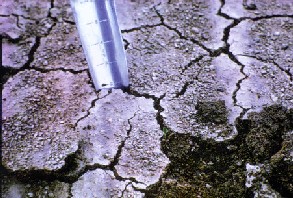
|
Soil StructureAll the effects of soil forming processes, weathering, translocation leaching and so on leave the soil with a particular 'structure'. Soil structure refers to the shape, size and degree of development of the aggregation, if any, of the primary soil particles into naturally or artificially formed structural units and to their spatial arrangement. In describing soil structure, we refer to soil 'peds' and soil fragments or 'clods'. Soil peds are natural, relatively permanent aggregates, separated from each other by voids or natural surfaces of weakness. Peds persist through cycles of wetting and drying. Soil Fragments and Clods are artificial structural units, formed at or near the surface by cultivation or frost action, and are not peds. Degradation of soil structures occur by a number of manners including: • Slaking - the breaking down of aggregates by rain impact or under wet conditions; sorting soil particles and washing them into depressions – such slaking can form surface crusts or caps hindering shoot emergence in young crops. The winter of 2002 in the UK saw many fields in the South East becoming 'capped' by the intense pounding of rain on the soil surface - which dramatically affected subsequent soil water runoff. • Cementation - in certain cases, a subsoil iron 'pan' or hard ferrous layer can form, effectively preventing root penetration. Iron pans can be surprisingly hard, and if dug out can be held up and may need to be 'snapped' to break them! • Sodium leaching - as saline soil solutions are diluted, sodium-saturated clays become unstable causing clay deflocculation and structural collapse. • Cultivation - the downward compression from machinery when the soil is too 'plastic' can form a barrier to rooting and drainage as massive or platy structures form. This emphasises the need for the correct design of vehicles designed to work the soil. The following picture highlights a highly compressed soil, with a massive structure showing horizontal fracturing and stressed roots. So called 'plough pans' can also form if a plough of a set depth is used over and over again year after year. Where this happens a hard layer of soil can build up just under the depth of the plough. This hard layer can impede field drainage and adversely affect crop yield.
|
